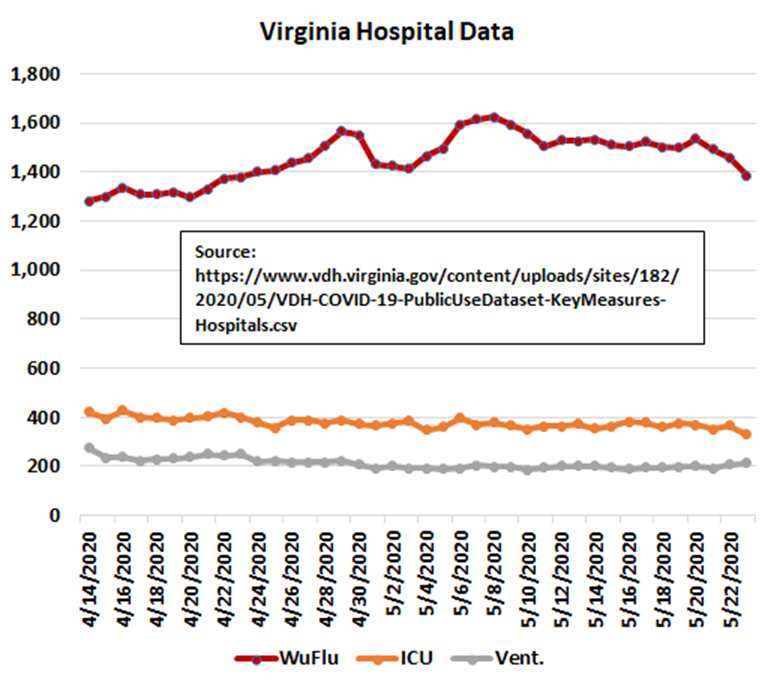
by James A. Bacon
We’re a week into Phase 1 of relaxing the COVID-19 lockdown, and there is no sign of an acceleration of the virus. To the contrary, the virus seems to be receding. It may be too soon to reach definitive conclusions — there is a one- to two-week lag between an infection, the display of symptoms, testing, and hospitalizations — but so far, all signs are positive.
The most reliable indicator is COVID-19 hospitalizations, and the daily number is trending down strongly, as can be seen in the graph (courtesy of John Butcher) shown above. Since May 15, the count of confirmed and suspected COVID-19 patients in Virginia hospitals has declined from 1,511 to 1,384. Meanwhile the number of new hospitalizations yesterday dropped to 36 — the lowest number in 25 days. The number of deaths remains significantly below previous peaks.
The one disconcerting note in the numbers comes from nursing homes. The number of nursing home patients confirmed to have COVID-19 has increased markedly over the past week — from 1,427 five days ago (the first day for which the numbers were reported) to 1,886 yesterday. Whether that reflects an increase in testing at long-term care facilities, an increase in the number of nursing homes sharing data, or an actual spread of the virus is impossible to determine from the published data on public dashboards.
(Of the 23 deaths reported yesterday, 14 were attributed to long-term care facilities — about 61%. When it comes to mortalities, the COVID-19 epidemic remains primarily a nursing home epidemic.)
Another data set suggesting that the epidemic is receding can be seen in the number of tests administered. The Northam administration had set a goal of administering 10,000 tests per day. The state lab and hospitals have the capacity to administer a few thousand tests; the rest of the tests come from private labs, primarily in response to tests ordered by physicians in response to patients showing possible COVID-19 symptoms. The number of tests administered daily runs in the 6,000 to 7,000 range — significantly below capacity.
Why aren’t there more tests? One possible explanation is monumental incompetence of Virginia’s public health authorities. One should never discount the possibility of incompetence. But there’s another possible explanation: Fewer people are getting tested because fewer people are displaying symptoms associated with COVID-19. It has been widely conjectured that longer days, warmer temperatures, and sunnier weather would dampen the spread of COVID-19 as it does the cold and flu. And that may be exactly what’s happening.
Remember, throughout the epidemic, 75% to 85% of COVID-19 tests were negative. Rarely did people get tests just for yuks. People were tested when they showed symptoms — dry coughing, aches and pains, etc. — consistent with the coronavirus. As it happens, most suspected COVID-19 cases turned out just to be a cold or flu. As happens every summer, flu and cold cases are receding, so fwer people are displaying flu-like systems, and fewer are getting testing. Because the COVID-positive results as a percentage of all tests has remained constant — between 14.0% and 15.0% every day over the past week — it appears that the incidence of COVID-19 is declining along with the incidence of cold and flu.
The good news is that summer should bring a respite in the COVID-19 epidemic. This should give Wise King Ralph the license to further loosen his death grip on the economy. The bad news is that the epidemic could surge again this fall as temperatures cool and days get shorter. But, hopefully, the next four months will buy us time to develop better medical treatments (if not vaccines) and bring down the mortality rate from the disease, and for places of employment and commerce to implement best practices to maintain hygienic standards and social distancing in public places.
The data provide ample justification for continuing to roll back the shutdown.

Leave a Reply
You must be logged in to post a comment.